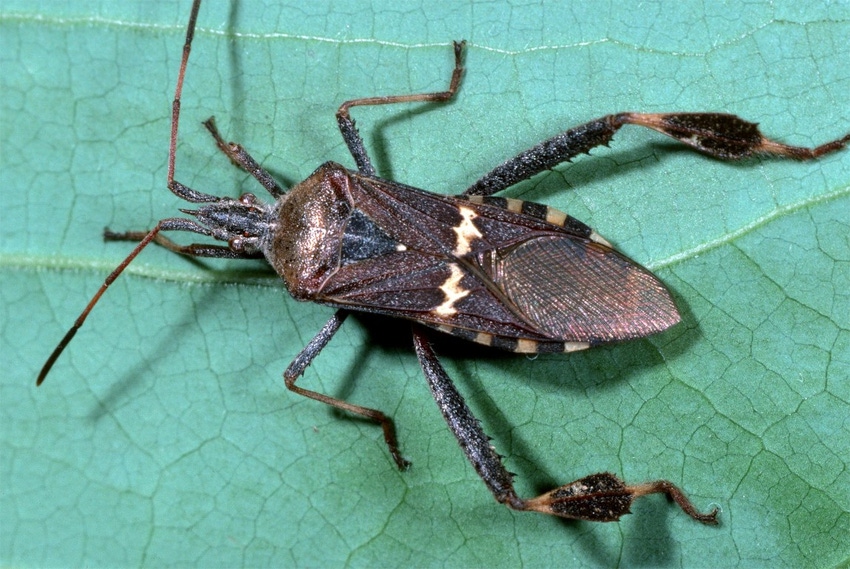February 17, 2016

A pest much more easily heard than seen can cause significant damage to almonds and pistachios.
It’s the leaffooted bug, which buzzes like a bumble bee, said Stephanie Rill, a University of California entomology research associate in Kern County.
The pest has been more of a problem in harvests that follow warm winters, Rill said. It over-winters in pomegranates, she explained, lays its brownish eggs in a line, and then migrates into almond orchards as adults to feed between March and May.
Rill said the pest has an aggregation pheromone, and adults are commonly found in groups. In woodpiles, the pest can be found under bark, in dense tree foliage, and hiding in palm fronds, citrus, and juniper during the winter.
In the almond orchard, each female can deposit more than 200 eggs. The eggs hatch but larvae die, Rill said.
In the summer and fall, the pest moves to other crops including pistachios.
Leaffooted bug has piercing and sucking mouthparts used as a straw. It is primarily a seed feeder causing damage in pistachios, almonds, juniper berries, and others. The proboscis can penetrate a pistachio shell late in the season even when it has hardened.
In almonds, penetration of the hull causes gummosis, leaving the nut on the tree to develop until harvest. But if there is penetration to the kernel, nut abortion may occur.
There’s a positive side to that, Rill noted, inasmuch damaged nuts do not make it to the huller. But the down side is a reduction in yield.
And if a kernel becomes damaged but remains on the tree, it likely will be off-graded as inedible at harvest.
Factors influencing susceptibility to quality damage include varietal differences. Rill found Fritz and Sonora as the most susceptible almond varieties on that count.
As for yield damage, the most susceptible include Fritz, Aldrich, Livingston, and Sonora.
She said shell hardness is not an indicator of susceptibility, but hull thickness is.
When monitoring for the pest, Rill said it’s wise to check for gummosis and to cut a cross section of the nut to see if probing was involved. Also, it’s good to look for nut drop.
She said the gummosis left by the leaffooted bug resembles bacterial spot, but can be distinguished from that. The bacterial spot is orange or reddish while the leaffooted bug leaves clear spots.
A biological control, which parasitizes eggs, is effective in the summer, but has no benefit against over-wintering adults that migrate to almonds.
Insecticides must contact the pest. Rill said Lorsban is excellent on contact, but has a residual of only one week, while pyrethroids including Brigade and Warrior II are excellent on contact and have a residual of more than four weeks.
She said Abameticin, Agri-Mek, and others are excellent on contact, but have no residual activity. Belay, Bexar, Sivanto, Beleaf, Exirel, and Sequoia have some contact activity but no residual activity.
Discussing monitoring and management in pistachios, Kris Tollerup, an integrated pest management advisor at the Kearney Ag Center, described the leaffooted bug as a “beast” that is difficult to kill and potentially a pest in several San Joaquin Valley crops.
He said researchers are trying to find a “plant volatile” that would act as pheromone to draw the pests, which would make monitoring easier.
Tollerup also pondered whether treating overwintering aggregations could protect neighboring host crops and whether colder temperatures could reduce populations. He said it appears that temperatures of 26 or 27 degrees for hours can significantly reduce populations.
He said leaffooted bug can be distinguished from stink bugs, which lay eggs in groups that are barrel-shaped. While stink bugs have two generations per year, the leaffooted bug has three over-lapping generations per year and possibly a fourth. Its eggs are laid in a tube-shaped group.
The damage to pistachios comes in late May and early June and can include lesions, abortion of kernels, and kernel necrosis.
Tollerup recommends sampling from late April to mid-July. He said adults are hard to spot because they quickly fly away if the top branches of trees are tapped.
“But you can see their silhouettes as they fly away,” he said.
You May Also Like




